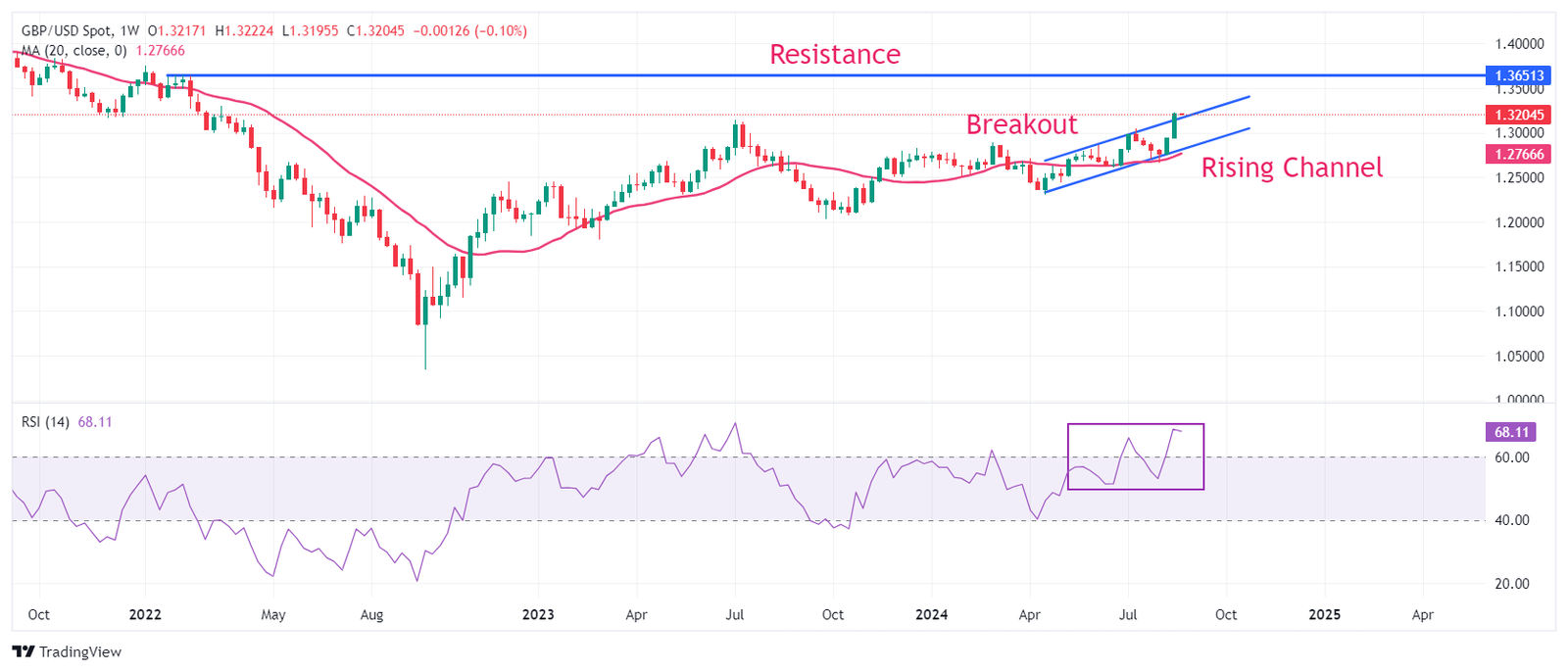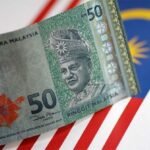- The Pound Sterling holds strength against the US Dollar to near 1.3200 driven by the Fed’s Powell dovish guidance on interest rates.
- Fed Powell’s comments suggested he remains concerned over downside risks to the US labor market.
- BoE’s Governor Andrew Bailey refrained from committing a specific interest-rate cut path.
The Pound Sterling (GBP) trades close to an almost two-and-a-half-year high near 1.3200 against the US Dollar (USD) in Monday’s London session. The GBP/USD pair aims to extend its seven-day winning streak as the US Dollar weakens after the unambiguous announcement from Federal Reserve (Fed) Chair Jerome Powell, who said that the central bank will start cutting interest rates in September.
The US Dollar Index (DXY), which tracks the Greenback’s value against six major currencies, hovers near a fresh year-to-day (YTD) low of 100.53.
In the speech at the Jackson Hole (JH) Symposium on Friday, Fed Powell said: “The time has come for policy to adjust.” However, he refrained from committing to a preset interest-rate cut path and preferred to remain data-dependent, saying that “the direction of travel is clear, and the timing and pace of rate cuts will depend on incoming data, the evolving outlook, and the balance of risks.”
Powell’s comments indicated that the central bank is now more worried about deteriorating labor market conditions and that he is confident that price pressures will return to the desired target of 2%. He commented that upside risks to inflation have diminished and downside risks to the labor market have increased. “We will do everything we can to support a strong labor market as we make further progress toward price stability,” Powell added.
This week, the major trigger for the US Dollar will be the United States (US) core Personal Consumption Expenditure Price Index (PCE) data for July, which will be published on Friday. Month-over-month, PCE inflation is estimated to have grown steadily by 0.2%.
In Monday’s session, investors will focus on the US Durable Goods Orders data for July, which will be published at 12:30 GMT. New Orders for Durable Goods, a key measure of core consumer inflation, is estimated to have grown at a robust pace of 4% after a significant decline in June. Nothing will come from the Pound Sterling side as the United Kingdom (UK) is on a bank holiday.
Daily digest market movers: Pound Sterling capitalizes on optimism over BoE’s gradual policy easing
- The Pound Sterling performs strongly against its major peers, except for Asia-Pacific currencies, at the start of the week. The British currency gains as the Bank of England (BoE) is reluctant to offer a preset rate-cut path given that the victory over inflation in the UK is far from over.
- BoE Governor Andrew Bailey signaled in his speech at the JH Symposium on Friday that the second-round effects of inflationary pressures could be smaller than expected, but added that the central bank should not rush for more interest rate cuts, Reuters reported. The BoE would “be careful not to cut interest rates too quickly or by too much,” Bailey said.
- Andrew Bailey also ruled out the risks of a potential recession and assured that the steady disinflation in the UK is aligned with the aim of achieving a soft landing for the economy.
- This week, the Pound Sterling will be guided by the market speculation for BoE interest rate cuts amid an absence of top-tier economic data in the UK. Currently, market participants expect that the BoE will deliver one more interest-rate cut this year. The BoE opted for a cut on August 1, with a close 5-4 split among its Monetary Policy Committee members. However, a slew of upbeat economic data, including stronger-than-expected flash S&P Global/CIPS PMI for August, has weighed on expectations for another rate cut in September.
Technical Analysis: Pound Sterling posts fresh two-and-a-half year high near 1.3200
The Pound Sterling softens slightly against the US Dollar but remains close to 1.3200 after delivering a breakout of the Rising Channel chart formation on the weekly time frame. The GBP/USD pair posts a fresh, almost two-and-a-half-year high, and it is expected to extend its upside towards the February 4, 2022, high of 1.3640.
The upward 20-week Exponential Moving Average (EMA) near 1.2766 suggests a strong upside trend.
The 14-period Relative Strength Index (RSI) oscillates in the bullish range of 60.00-80.00, suggesting a strong upside momentum. Still, it has reached overbought levels at around 70.00, increasing the chances of a corrective pullback. On the downside, the psychological level of 1.3000 will be the crucial support for the Pound Sterling bulls.
Pound Sterling FAQs
The Pound Sterling (GBP) is the oldest currency in the world (886 AD) and the official currency of the United Kingdom. It is the fourth most traded unit for foreign exchange (FX) in the world, accounting for 12% of all transactions, averaging $630 billion a day, according to 2022 data. Its key trading pairs are GBP/USD, aka ‘Cable’, which accounts for 11% of FX, GBP/JPY, or the ‘Dragon’ as it is known by traders (3%), and EUR/GBP (2%). The Pound Sterling is issued by the Bank of England (BoE).
The single most important factor influencing the value of the Pound Sterling is monetary policy decided by the Bank of England. The BoE bases its decisions on whether it has achieved its primary goal of “price stability” – a steady inflation rate of around 2%. Its primary tool for achieving this is the adjustment of interest rates. When inflation is too high, the BoE will try to rein it in by raising interest rates, making it more expensive for people and businesses to access credit. This is generally positive for GBP, as higher interest rates make the UK a more attractive place for global investors to park their money. When inflation falls too low it is a sign economic growth is slowing. In this scenario, the BoE will consider lowering interest rates to cheapen credit so businesses will borrow more to invest in growth-generating projects.
Data releases gauge the health of the economy and can impact the value of the Pound Sterling. Indicators such as GDP, Manufacturing and Services PMIs, and employment can all influence the direction of the GBP. A strong economy is good for Sterling. Not only does it attract more foreign investment but it may encourage the BoE to put up interest rates, which will directly strengthen GBP. Otherwise, if economic data is weak, the Pound Sterling is likely to fall.
Another significant data release for the Pound Sterling is the Trade Balance. This indicator measures the difference between what a country earns from its exports and what it spends on imports over a given period. If a country produces highly sought-after exports, its currency will benefit purely from the extra demand created from foreign buyers seeking to purchase these goods. Therefore, a positive net Trade Balance strengthens a currency and vice versa for a negative balance.






















